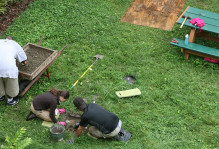Trends
December 27, 2009
No Comments
From 9/11 to exploding budget deficits and the election of our first African American president, the “aughts” were a decade of significant surprises for the nation. There also were a lot of surprises at W&M – just to name a few, the incredible strides that the admissions office made in attracting an increasingly talented and diverse student body, the alarming budget cuts, I suppose, and of course some invigorating athletic outcomes like the 2009 football victory over that team from Charlottesville.
There will be more surprises over the next decade for the U.S. and also for the College of William and Mary. But based on the past few years, the following ten trends strike me as almost certainly in the cards.
- Our students, I expect, will continue to get smarter and more accomplished. My faculty colleagues and I would love to claim all the credit for all that our students accomplish, but the fact is that the raw material we get freshman year is very strong and getting stronger. In contrast to most other states, the 18-22 year old demographic will not significantly diminish in size in Virginia, and abundant professional opportunities throughout the Commonwealth will continue to attract smart parents who care a lot about educating their children, further enhancing our applicant pool. Ten years from now, our current students, then in their thirties, will almost certainly echo what I regularly hear from today’s alumni – “There’s no way in hell that I could get into W&M given the current standards.”
- My guess is there will be even greater variance in course sizes at the College. When I arrived at W&M in 1987, most classes were comprised of around 35 students. This cookie-cutter approach to class sizes doesn’t make much sense, at least to me. Certain material, especially for introductory classes, can be effectively taught in large lecture courses with 200 or more students. Other courses, research-intensive classes that require a lot of close faculty-student interaction, for instance, need to be much smaller, enrolling 10 students or less. Over the past few years, we have done a better job at tailoring class sizes more to the underlying material and the course-specific needs of student and this should continue. My guess is that we will see more small classes and more large classes at the College over the next ten years.
- In my view, the overall size of the W&M student body may have to grow somewhat. We now have around 5,700 undergraduates and almost 2,000 graduate students at the College. The increase in the number of university-aged students in Virginia and the growing cost of a private university education will substantially increase the demand for entrance at W&M. I think that you can count on there being serious pressure to grow the size of our student body by four or five hundred students. Informed people disagree about the appropriate size for the College, but in my view at least, increases of this magnitude should be doable. For one, every year more of our students participate in study-abroad programs or complete outside internships that grant credit, thereby opening up some spaces for additional students here in Williamsburg. Still, an important challenge for the College may be accommodating a somewhat larger student body while maintaining the close faculty-student relationships that are our hallmark.
- Building on the last point, the proportion of W&M undergraduates who spend at least one semester away from Williamsburg studying abroad, or participating in programs like our Washington semester that involve internships for course credit, will probably rise significantly. Part of the magic of the liberal arts is that what we teach and learn about in courses at the College really does inform real world experiences beyond the Ivory Tower. More and more, I think, W&M faculty and students are going to look for ways to integrate traditional academic work with internships and other applied experiences. And as the world continues to grow smaller and people’s life experiences become less defined by nations and borders, I expect that more and more W&M students will travel and study outside the U.S. as part of their undergraduate educations.
- Unfortunately, I fear that the percentage of operating funds that we receive from the state will continue to decline, probably falling below 10 percent by the end of the next decade. When I arrived at W&M in 1987, about one-third of our operating budget was covered by the state. After the latest round of cuts from Richmond, that contribution is now down to just 14 percent. Ouch! However, the end of the Obama stimulus infusion in December 2010, growing health care and transportation expenditures by the Commonwealth, and the mushrooming federal budget deficit together will necessitate additional waves of budget cuts for public higher education in Virginia and across the nation. This is unfortunate but unavoidable, at least in my view.
- For this reason, tuition at public universities in Virginia and the U.S. probably will have to increase substantially. The total cost (tuition, room and board, books, and travel) at W&M is now around $22,000 per academic year for in-state students and about twice that for non-Virginians. Expect those figures to rise significantly, especially for Virginia residents. Even at $22,000 the total price tag of a W&M education is still substantially below the real cost of providing that service. In previous decades, we could rely on Richmond to make up the difference, with taxpayers essentially subsidizing families with children in public colleges and universities. As a result of the aforementioned budget deficits, however, those days appear to be gone. A key challenge for the College also will be a continued commitment to student aid so that all deserving students have the financial means necessary to attend W&M.
- Even though W&M will maintain its historic commitment to the liberal arts, I expect there to be increased emphasis on professional development and the myriad ways that we can prepare students for graduate programs and the world of work. In my view, there is no better preparation for making a contribution in the workplace than a broad exposure to the liberal arts, especially the emphasis on critical reasoning and writing skills. But as we complete the building of our new and expanded career center at the College, I believe that we are going to seriously step up the help we give students in clarifying their professional plans and provide more concrete and practical guidance about how to translate those plans into reality.
- The W&M name brand is going to get even stronger. This is just one guy’s opinion, so take my view for what it’s worth. But I really think that much of what passes for higher education in this country is dysfunctional. So many American students attend mega-universities with 30,000 or more undergraduates, take almost all of their classes in large impersonal lecture formats, and over four years never really get to know any of their professors. Within this environment of research-oriented institutions dominated by graduate teaching assistants and faculty focused almost exclusively on publications over teaching, W&M stands out among our premier public universities as exactly the kind of place that most parents want to send their children. We will continue to have a uniquely attractive market niche in higher education. As the College becomes more adept at communicating its core strengths, W&M will grow even more visible and prominent.
- Our graduates are going to accomplish some really exciting things over the next decade or so. Just look at the quality of their academic and community service work while they are here. Personally, I’m looking forward to the November when one of my former students in GOVT 370, Legislative Processes, gets elected to the U.S. Congress. I’ve been teaching that class at the College for over 20 years, and given the abilities of my students it is inevitable that sometime soon one of them will end up as a member of the U.S. House or Senate. And you can be sure that within a day or two of that election, I’ll be in contact with the lucky alum asking about internships for our current students.
- God willing, I’ll still be here in ten years when 2019 draws to a close. When I started at the College in the late 1980s, the plan was to spend three or four years at W&M, do as much fieldwork in Washington as possible for my research, publish a book and some articles, and then move on to a bigger university. But I quickly became enamored with the remarkable intellectual environment and resources at the College, and deeply impressed by the quality and decency of the students here. Working at the College year after year also affected my professional values in subtle ways, coaxing forth a fairly deep commitment to the linkages that exist between research and teaching, as well as other aspects of the W&M culture. So unless I get hit by a bus, or I can’t keep up with rising standards for faculty at the College (a real possibility, given the quality of our recent hires) I’m here to stay. Happy New Year (and decade)!
Categories: Academics, Faculty & Staff Blogs




No comments.
Comments are currently closed. Comments are closed on all posts older than one year, and for those in our archive.